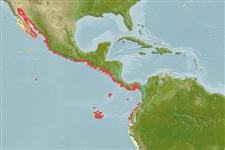Environment: milieu / climate zone / depth range / distribution range
Ecology
Marine; demersal; depth range 46 - 90 m (Ref. 9342). Subtropical; 33°N - 10°S, 116°W - 78°W (Ref. 5222)
Eastern Pacific: southern California in the USA, south to Peru.
Size / Weight / Age
Maturity: Lm ? range ? - ? cm
Max length : 100.0 cm TL male/unsexed; (Ref. 5222)
Dorsal spines (total): 11; Dorsal soft rays (total): 16 - 18; Anal spines: 3; Anal soft rays: 8. Distinguished by the following characteristics: dark red or brown head and body; darker pectoral fins than body; tips of interspinous dorsal fin membranes darker than the rest of the membranes; prominent black moustache streak occurs above maxilla; depth of body contained 2.4-2.6 times in SL; head length 2.3-2.4 times in SL; convex interorbital area; rounded preopercle, finely serrate, enlarged serrae at angle but covered by skin; distinctly convex upper edge of operculum (Ref. 89707).
Common in the Gulf of California. Occasionally encountered in isolated reefs and sandy bottoms near the coast at depths of 46 to 90 m; uncommon in shallow waters (Ref. 89707).
Life cycle and mating behavior
Maturity | Reproduction | Spawning | Eggs | Fecundity | Larvae
Craig, M.T. and P.A. Hastings, 2007. A molecular phylogeny of the groupers of the subfamily Epinephelinae (Serranidae) with revised classification of the epinephelini. Ichthyol. Res. 54:1-17. (Ref. 83414)
IUCN Red List Status (Ref. 130435: Version 2024-1)
Threat to humans
Harmless
Human uses
Fisheries: minor commercial
Tools
Special reports
Download XML
Internet sources
Estimates based on models
Preferred temperature (Ref.
123201): 17 - 26, mean 19.9 °C (based on 16 cells).
Phylogenetic diversity index (Ref.
82804): PD
50 = 0.5001 [Uniqueness, from 0.5 = low to 2.0 = high].
Bayesian length-weight: a=0.01072 (0.00607 - 0.01892), b=3.03 (2.88 - 3.18), in cm total length, based on LWR estimates for this species & Genus-body shape (Ref.
93245).
Trophic level (Ref.
69278): 3.9 ±0.7 se; based on size and trophs of closest relatives
Resilience (Ref.
120179): Very Low, minimum population doubling time more than 14 years (Preliminary K or Fecundity.).
Fishing Vulnerability (Ref.
59153): High vulnerability (60 of 100).
Nutrients (Ref.
124155): Calcium = 39.8 [16.6, 82.2] mg/100g; Iron = 0.73 [0.39, 1.41] mg/100g; Protein = 18.9 [17.0, 20.6] %; Omega3 = 0.353 [0.211, 0.601] g/100g; Selenium = 30.9 [14.9, 65.2] μg/100g; VitaminA = 12.5 [3.6, 49.6] μg/100g; Zinc = 0.516 [0.363, 0.769] mg/100g (wet weight);
